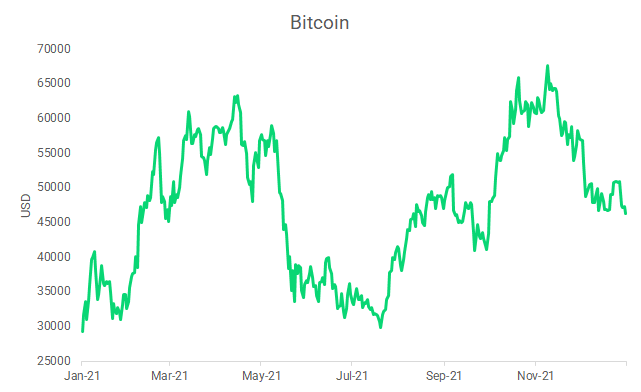With a roller-coaster 2021, Bitcoin remains one of the most mysterious assets on the market. Will it keep rising or are cracks starting to appear?
Introduction
Bitcoin hit its last all-time high last November, when it topped USD68’000 for the first time. The victory was short lived: the crypto asset reverted back below USD46’000 in December.

Even though this might seem low, it was still an enormous increase for the year, as Bitcoin started January under USD30’000. Its price remains highly volatile, moving between USD58’000 and USD46’000 in December alone.
Despite such a hazardous path, many experts are confident that Bitcoin will reach the USD100’000 mark. BTC keeps rising, and many wonder how high it can ultimately go. As always, it is impossible to know how much an asset will be worth in the future, but here are some of our best guesses.
BTC Price predictions
Of course, experts disagree on predictions, though some conservative predictions expect the price of a Bitcoin to reach USD10’000 by 2023. Some institutions are much more bullish, like JPMorgan, predicting a long-term high of USD146’000.
Over the long term, most crypto-enthusiast agree that Bitcoin will keep rising and eventually pass USD100’000 – and some have no limits, like Robert Breedlove, CEO of digital assets marketing and consulting firm Parallax Digital, who believes that BTC will reach USD12.5 million by 2031.
As of the next few months, we see two potential scenarios:
The bear case
First, retail investors do not have the same investable cash as they did during the pandemic. In fact, disposable income is barely above pre-pandemic level, with less stimulus, on and off shutdowns, and high inflation eating into salaries. Consumers need to keep money for gas and food, suggesting a large group of retail investors get out of risky asset and focus on priorities. In addition, with people going back to work, there is less to sit at home and trade than at the height of the pandemic.
Additionally, institutional adoption is turning the crypto space into an asset that fluctuates with exterior influences, losing some of its previous independence. The structure of the market has greatly changed, as institutional investors rebalance their portfolios, which can weigh on prices.
The bull case
Conversely, institutional adoption continues to grow significantly. There are currently more than 800 crypto-focused hedge funds and venture capital firms alone. While the end of the year might have led to some profit taking, it also makes it likely many institutions engage with cryptocurrencies early in the new year, building positions for 2022.
This could balance out the lack of retail participation as the institutional capital of hedge funds and venture capital firms sitting on the side-lines gets invested.
Drivers to keep in mind
There are many factors influencing the price of bitcoin. Of course, BTC is influenced by traditional factors like supply and demand, market sentiment, news, and market events, but it also has its own specific drivers.
Scarcity
19 million bitcoins have already been mined, meaning that there will be only 2 million more before the project reaches its 21 million limit. Industry experts consistently point to this built-in scarcity as a big part of the cryptocurrency’s appeal. Indeed, a fixed supply and an increasing demand can take away the need for complicated math.
Other experts argue that Bitcoin only has the value people give to it. The whole concept of supply and demand only works when people want something scarce — even if it previously didn’t exist. Many fear a scam, or at least do not believe crypto to be a robust asset: even though some made millions, many have also seen vast sums vanish overnight.
Mainstream adoption
Of course, the rate at which new consumers are buying and exploring cryptocurrency is a strong growth factor for bitcoin. And people seem to be adopting this new technology faster than they did the internet. Bitcoin adoption has been increasing at an annual rate of 113% (vs. 63% for the internet), according to data from the digital asset management firm CoinShares. At this rate, there could hypothetically be 1 billion users by 2024 and 4 billion users by 2030.
The number of wallet worldwide also increased in the past year: 45% from January 2020 to January 2021, to an estimated 66 million. In other terms, more and more people are into crypto.
Mining cycles
Halving, the process by which the reward given to bitcoin miners is reduced by half every four years, also has a major influence of the price of bitcoin. Historically, halvings have correlated with boom-and-bust cycles, so investors should beware of selling and buying bitcoin around these times. See previous article.
Volatility
More than most other assets, Bitcoin has proven a very volatile asset. While adopters see it as a store of value, its volatility and correlation to risk assets like equities (see vs the S&P500 index) brings that into question. Indeed, it has trade more in line with big tech than as a hedge, something to keep in mind as 2022 could prove bumpy for many asset classes.
Regulation
Regulation will be one of the big questions of the next few years, as it has a strong influence on markets. The US has been clear on the matter and really wants to get better control over this very volatile new asset. Interestingly, when China banned cryptos, the price of Bitcoin stumbled, though it quickly bounced back.
Regulation has changed back and forth in many countries, and the decisions of officials could greatly impact the future performance of bitcoin.
Conclusion
The adoption of cryptocurrencies, and of Bitcoin in particular, is, in our view, not in question. Both in terms of retail investors and institutions, demand for Bitcoin is growing, which should support prices in the coming years. It has not worked as well as some had anticipated as a store of value or a hedge against inflation, so investors should expect volatility to come hand in hand with their investment in this space. Still, demand usually leads to higher prices, a trend we believe will continue for 2022.





